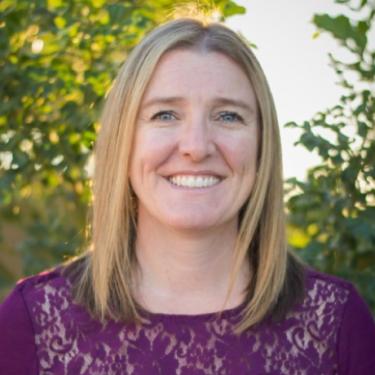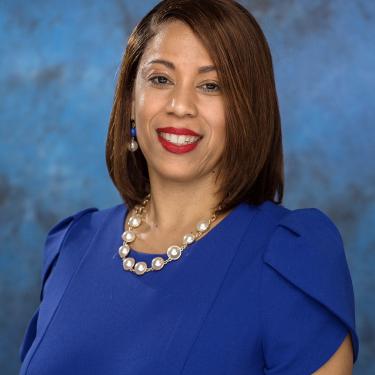At UAGC, we are committed to academic excellence by promoting and supporting effective learning environments for all students to realize this goal, we collaborate with faculty and other campus partners, drawing on our wide range of expertise in course and program design, educational technology, assessment, learning spaces, and curricular research. We provide faculty and academic leadership support through the collection, compilation, and analysis of information that leads to informed decision-making to support educational effectiveness efforts. The result is a continuous cycle of goal setting, measurement, and action, which leads to systematic improvements in instructional effectiveness, an enhanced learning environment, and, most importantly, a better learning experience with greater levels of student success.
Office of Assessment & Curricular Affairs Leadership Team
Program Review
Program Review is a continuous process for evaluating and improving the quality and effectiveness of academic and non-academic (co-curricular) programs. Program review involves a thorough, evidence-based evaluation of a program's strengths and areas for improvement. Every five years, faculty engage in a 12-month-long program review process. Staff from the Office of Assessment and Curricular Affairs support and collaborate with the faculty during this time by leading a kickoff meeting at the beginning of the process, setting up a Teams site for collaboration, and providing program-specific data and resources. Some of the key data metrics include enrollment, retention, persistence, graduation rate, course completion rates, student and faculty demographics, and End of Course Survey and Alumni Survey data. Faculty are provided various resources, including templates, guides, and examples to assist in drafting the self-study document.
The first phase of a program review is self-study. The self-study phase includes inquiry, data analysis, and self-reflection, which culminate in a self-study document that summarizes key findings and insights. This phase is faculty-led and should involve the entire program faculty, as well as invite input from other stakeholders such as students, alumni, and administrators. Throughout the process, formal check-ins are scheduled at the fourth, fifth, seventh, eighth, and eleventh month marks by the staff to ensure that deadlines are being met.
The peer review phase affords programs a unique external perspective in identifying strengths, opportunities, and areas for growth. Two external reviewers that serve as subject matter experts from other institutions are invited to participate in a two-day virtual review as part of the program review process. The self-study is made available to the external reviewers two weeks prior to the virtual visit as part of the external review process. The external reviewers provide a critical evaluation of the program and make recommendations for improvement. At the conclusion of the visit, a report is provided by the external reviewers. This report contains key findings and recommendations based on the self-study, information obtained during the site visit, discussions with fellow reviewers, and the background and expertise of the review team.
The self-study and peer-review/site visit phases provide the program with opportunities to reflect on the strengths of the program and possibilities for its improvement. Now, faculty take some of the lessons learned and transform them into achievable ambitions for the program, as expressed in a strategic action plan. Faculty create action items and interventions that are aligned to strategic initiatives, enrollment, retention, and/or student learning. The action plan is mission-driven, strengths-based, and forward-leaning; it is grounded in a clear sense of shared purpose, addressing concerns but not limited to them, and informed by aspirations for the program during the next stage in its development. The action items are the other final deliverable for the program review process and are approved at the Department Chair and Dean levels. The results generated from this in-depth, data-driven, multi-perspective analysis are used to inform planning and budgeting with the ultimate goal of continuous improvement. The action items are monitored and tracked on a quarterly basis by the staff over the course of the next five years until the next program review cycle.
Practicum & Internships
The Bachelor of Science in Health Information Management (BSHIM) and the Master of Public Health (MPH) within the College of Arts and Sciences include an on-site internship/practicum requirement where students are provided an opportunity to work in a professional environment under the supervision of an expert in that field. As part of the programs' requirements, students are required to submit a criminal background check prior to enrolling in the program and starting the practicum. The Practicum Specialist facilitates the criminal background check at both checkpoints for the student to ensure that students are prepared.
The BSHIM meets the American Health Information Management Association (AHIMA) accreditation which includes the 40-hour Professional Practice Experience requirement. Students complete this internship during their last class of the program over a five-week period. Most commonly, students complete the hours within one-to-two work weeks, where they are assigned two Health Information Management (HIM) projects and required to attend a departmental or organizational meeting, review an annual budget, and present an HIM topic to a small group.
The MPH requires a 90-hour practicum experience, where the student addresses a public health disparity. The 90 hours are completed over the last nine to 18 weeks of the student’s program, with a maximum of nine hours completed per week. Remote opportunities are accepted, though most experiences are on-site or hybrid in nature. The practicum concludes with the submission of a written report of the experience and a formal presentation to the Faculty Advisor/Mentor and the Program Chair.
Students in both programs are responsible for identifying a local facility willing to host them, and the Practicum Specialist supports the student in executing the affiliation agreement between UAGC and the facility. The Practicum Specialist is also responsible for maintaining all records associated with each student, including but not limited to affiliation agreements, memorandums of understanding, hourly log charts, supervisor feedback forms, student feedback forms, and student work associated with the practicum experience. The Practicum Specialist also serves as a resource and advisor for BSHIM and MPH students to ensure that students are on track to complete their practicum prior to graduation. Each program has a specific Practicum Resource Center (PRC) located in Canvas, and the Practicum Specialist manages both PRCs to ensure that the program-specific handbooks and forms are current. Students can also contact the Practicum Specialist directly via email, via the PRC, or through program-specific inboxes BSHIMPPE@uagc.edu and MPH-practicum@uagc.edu).
Assessment
UAGC assessment practices are centered around the mission and critical goals focused on educational quality and effectiveness. The assessment cycle begins with specific, actionable outcomes, and evidence is gathered to improve student and institutional performance.
UAGC has institutional learning outcomes (ILOs) that are aligned to NACE Competencies, Lumina DQP, and WSCUC Core Competencies. General Education Learning Outcomes (GELOs) are assessed across all degree programs and are also aligned to WSCUC Core Competencies. Each program has designated learning outcomes that are aligned to the ILOs, GELOs, and WSCUC Core Competencies. Within each course, there are course learning outcomes that align to the program learning outcomes (PLOs) and are measured in learning activities and assessments.
Supporting faculty in assessment is the Vice President of Curriculum and Assessment and Assessment Specialists.
The Assessment Specialists collaborate with faculty to ensure every course and program has measurable, achievable, and relevant learning outcomes which communicate to students the knowledge, skills, and values they are expected to obtain upon graduating. They also ensure the learning outcomes are appropriately scaffolded in the course, aligned to all elements of the course, and measured throughout each course and program. Faculty create grading rubrics which are used in Waypoint Outcomes to assess student learning.
The assessment cycle at UAGC follows the academic year, spanning the period from July 1 to June 30. A full assessment cycle involves curriculum mapping, assessment planning, data collection, analysis and reporting, continuous improvement planning, and data-based actions for each UAGC undergraduate and graduate degree program.
During each assessment cycle, program chairs or appointed full-time faculty are asked to review the curriculum map from the previous cycle and adjust as necessary to indicate the required course’s PLOs are currently introduced, reinforced, or mastered. Once the curriculum maps have been completed, faculty collaborate to develop program assessment plans for the year. Faculty work with assessment analysts to identify several appropriate indirect (e.g., survey items, assignment grades) and direct (e.g., assignment evaluation data collected with the Waypoint Outcomes assessment tool, standardized tests) measures of student achievement of each PLO. For each measure selected, the faculty also set acceptable and ideal targets for student performance.
Assessment specialists maintain the curriculum maps and assessment plans prepared by the faculty for appropriate recordkeeping and use this information to guide data collection, analysis, and reporting efforts. At the close of the assessment cycle, findings for each assessment measure are delivered to faculty for review. Based on the data, faculty then develop program continuous improvement plans with actions to be taken to improve student achievement of selected PLOs. Actions planned and taken are also documented by the assessment specialists. For each program, faculty set actions and timelines for completion related to one or two PLOs per year. Faculty will create continuous improvement plans with actionable programmatic and curricular revisions associated with all PLOs within a 5-year period to remain consistent with the 5-year program review cycle at UAGC.
Curriculum
Student success is at the heart of our mission. By having a comprehensive model for curriculum design that integrates assessment practices, the University of Arizona Global Campus provides a consistent and interconnected approach to the development, alignment, and analysis of student learning outcomes.
Supporting both curriculum development and assessment of student learning is a team comprised of the Director of Learning Solutions, assessment specialists, academic content specialists, multimedia production lead, video production operations lead, and academic quality assurance specialists.
Leading a dynamic team of curriculum experts who partner with faculty to ensure that every aspect of course design and development meets the highest standards of quality and relevance, the Director of Learning Solutions is responsible for driving the continuous improvement of courses and curriculum. The Director fosters a culture of creativity and experimentation, where new pedagogical approaches are encouraged and evaluated for their effectiveness. They maintain a deep understanding of the evolving needs of students and the broader educational landscape, to ensure that the institution's courses provide an impactful educational experience for students.
The Assessment Specialists collaborate with faculty to ensure every course and program has measurable, achievable, and relevant learning outcomes which communicate to students the knowledge, skills, and values they are expected to obtain upon graduating. They also ensure the learning outcomes are appropriately scaffolded in the course, aligned to all elements of the course, and measured throughout each course and program. Faculty create grading rubrics which are used in Waypoint to assess student learning.
The data captured from Waypoint is used to analyze these outcomes and is utilized by faculty to update and improve curriculum processes, program alignment, course design, course content, and course delivery methods.
Academic Content Specialists build each course in the learning management system. They work closely with all stakeholders involved in the course development process, including the faculty, video and multimedia producers, assessment specialists, and the Learning Technology team, to ensure each course is built according to the design standards of the university.
A critical area of course design is the creation of innovative and engaging multimedia and video production.
Our Multimedia Production Lead collaborates and ideates with faculty on creating interactive animation and/or other multimedia learning objects, including interactive UX/UI design, 3D/2D design, animation, accessibility, and publishing. The multimedia designer resolves any multimedia repairs, changes, and bug fixes in addition to collating and analyzing deliverable projections, project data, and forecasting.
The Video Production Operations Lead oversees and performs all aspects of video production for UAGC courses. These duties include meeting with stakeholders to discuss scope and deadlines, establishing milestones, creating storyboards, voice-over recording, creating and collecting assets, editing, publishing, ordering and receiving transcripts and closed captioning, occasionally supporting third party vendor projects, and managing the storage of project files and assets.
Finally, Academic Quality Assurance Specialists support program review and curriculum development by acting as a quality assurance check by reviewing self-studies and course guides for accessibility, alignment, clarity, formatting, grammar, and syntax.
Academic Quality Services
Academic Quality Services aims to take an intentional approach to academic quality that is student-centric and collaborative, creating community through the practice of academic excellence. We strive to build positive interdepartmental relationships and workflows that remove obstacles and create innovative opportunities to best support student achievement of their academic goals. Academic Quality Services includes staff supporting academic integrity and the Incident Report Of Academic Dishonesty (IROAD) process and Quality Matters program certification and facilitation of the Quality Matters Applying the QM Rubric workshop. As part of the academic integrity and IROAD process, Academic Outreach Specialists support students and faculty on academic integrity processes and policies. The Academic Outreach Specialist reviews faculty-submitted IROADs and provides students with resources to avoid future academic integrity violations and coaching sessions for repeated incidents. In addition, they collaborate with related offices on faculty development, student success initiatives, and the promotion of academic integrity.
In addition to academic integrity, Academic Quality Services provides support for Quality Matters integration into the university’s curriculum, including program certification for academic programs in the areas of Online Program Design, Online Teaching Support, Online Learning Support, and Online Learning Success, as well as the facilitation of Quality Matters’ Applying the QM Rubric workshop for faculty and staff involved in the course development process.



